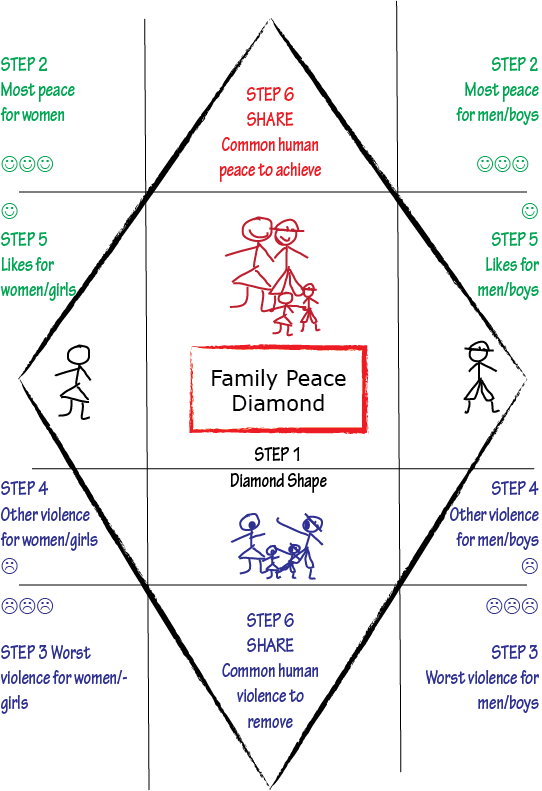For overview see:

diamond visions:
Generic Steps
STEP 1: Individual reflection
Participants identify what criteria they think characterise extreme opposites of an issue or spectrum eg poverty, empowerment, violence. They draw these extremes on a set number of colour-coded cards.

STEP 2: Sharing
Participants form groups of people as relevant to the issue and share their cards. A charade game is useful to improve visual communication: one person comes up and shows the card. The other participants have to guess what it means. Then those with the same issue/criteria hand their cards to the person at the front. That person sits down and the next person comes up until all cards are finished.

STEP 3: Voting
When participants have heard everyone else’s ideas, they get a certain number of votes. They come up and confidentially put a mark on the cards they want to vote on. Or they can vote by show of hands. The difference between the number of cards and the number of votes for any issue can be a rough indicator of changes in attitude/awareness as a result of the exercise.

4: Ranking
Participants then count the votes and place each set of cards on the relevant level of the diamond: best likes at the top, medium likes towards the middle, medium dislikes middle below the line, worst dislikes at the bottom.

5: Action priorities
Ring Action priorities in green as planned fruits. These are most likely to be the things that people really want, but that few people have. Or the things that people want least and many people have.
6: Plenary sharing and negotiation
Participants from each group presents their group Diamond – those who are normally least vocal should present first with others adding. One person removes the cards from their own drawing and, with discussion with the rest of the participants, places these cards either on their side or in the middle of the ‘parent diamond’. This identifies common indicators and potential lines of difference to establish common Codes of Conduct. This should include discussion of how participants can improve the situation of the most disadvantaged people at the bottom of the Diamond.


Tracking and Impact Assessment
Ring achievement of action priorities as red fruits. It is also possible to show impacts retrospectively for individual indicators as mini-wiggly-road journeys.
diamond Steps
STEP 1: INDIVIDUAL REFLECTION: Participants identify what criteria they think characterise extreme opposites: what they want to do as freedom for the top of the Diamond and the most extreme types of violence preventing them from enjoying this freedom at the bottom of the diamond. They draw these extremes on a set number of colour-coded cards.
STEP 2: SHARING: Participants share their cards within the group. This is a game like charades. One person comes up and shows the card, the others first have to guess what it means. Then those with the same issue/criteria hand their cards to the person at the front. That person sits down and the next person comes up until all cards are finished.
STEP 3: VOTING: When they have heard everyone else’s ideas, participants are then given a certain number of votes. They come up and confidentially put a mark on the cards they want to vote on. Or they can vote by show of hands. The difference between the number of cards and the number of votes for any issue can be taken as a rough indicator of changes in attitude/awareness as a result of the exercise.
STEP 4: RANKING: Participants then count the votes and place each set of cards on the relevant level of the diamond: best likes at the top, medium likes towards the middle, medium dislikes middle below the line, worst dislikes at the bottom.
STEP 5: ACTION PRIORITIES: Action priorities then ringed in green as planned fruits. These are most likely to be the things that people really want, but that few people have. Or the things that people want least and many people have.
STEP 6: PLENARY SHARING AND NEGOTIATION: Participants from each group presents their group Diamond – those who are normally least vocal should present first with others adding. One person removes the cards from their own drawing and, with discussion with the rest of the participants, places these cards either on their side or in the middle of the ‘parent diamond’. This identifies common indicators and potential lines of difference to establish common Codes of Conduct. In particular discussion of how the situation of people suffering at the bottom of the Diamond can be substantially improved.

